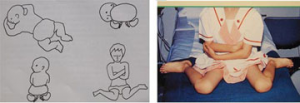Femoral Anteversion
What is femoral anteversion?
Femoral anteversion is an inward twisting of the thigh bone, also known as the femur (the bone that is located between the hip and the knee). Femoral anteversion causes the child’s knees and feet to turn inward, or have what is also known as a “pigeon-toed” appearance. It is twice as likely to be seen in girls and most typically occurs among toddlers.
What causes femoral anteversion?
Femoral anteversion can be the result of stiff hip muscles due to the position of the baby in the uterus. It also has a tendency to run in families. Typically, a child’s walking style looks like that of his/her parents.
When the child is first learning how to walk, femoral anteversion can create an intoeing appearance. As the knees and feet turn in, the legs look like they are bowed. The bowed leg stance actually helps the child achieve greater balance as they stand. Balance is not as steady when they try to stand and walk with their feet close together or with their feet turned out. This may cause them to trip and fall.
Treatment for femoral anteversion
Specific treatment for femoral anteversion will be determined by your child’s physician based on:
The twisting in of the thigh bone usually improves with time. As the child grows, normal walking patterns typically resume by 8 to 10 years of age.
Occasionally braces or special shoes are prescribed by the physician.
- your child’s age, overall health, and medical history
- the extent of the condition
- your child’s tolerance for specific medications, procedures, or therapies
- expectations for the course of the condition
- your opinion or preference
The twisting in of the thigh bone usually improves with time. As the child grows, normal walking patterns typically resume by 8 to 10 years of age.
Occasionally braces or special shoes are prescribed by the physician.
How is femoral anteversion diagnosed?
The diagnosis of femoral anteversion is made by a physical examination by your child’s physician. During the examination, the physician obtains a complete prenatal and birth history of the child and asks if other family members are known to have femoral anteversion.
Other diagnostic procedures may include:
Other diagnostic procedures may include:
- x-ray – a diagnostic test which uses invisible electromagnetic energy beams to produce images of internal tissues, bones, and organs onto film.
- computed tomography (Also called CT or CAT scan.) – diagnostic imaging procedure that uses a combination of x-rays and computer technology to produce cross-sectional images (often called slices), both horizontally and vertically, of the body. A CT scan shows detailed images of any part of the body, including the bones, muscles, fat, and organs. CT scans are more detailed than general x-rays.
- magnetic resonance imaging (MRI) – a diagnostic procedure that uses a combination of large magnets, radiofrequencies, and a computer to produce detailed images of organs and structures within the body.
In addition, some physicians place ink or chalk on the bottom of the child’s feet and have them walk on paper to evaluate the amount of intoeing the child has.
Long-term outlook for a child with femoral anteversion
Femoral anteversion has a very good prognosis. Many cases correct themselves as the child grows. On rare occasions, femoral anteversion can be severe and surgery may be required to straighten the thigh bone.
It is important to know that femoral anteversion typically does not lead to arthritis or any other future health problems
It is important to know that femoral anteversion typically does not lead to arthritis or any other future health problems

- Exacerbated by sitting in ‘W’ position
- More common in girls
- Many correct spontaneously by age 10 years
5-10% persist , but rarely require surgical correction
Note: All content presented on this website is intended for informational purpose only. The information on this website should not be used as a basis for diagnosis or treatment without an examination by a medical practitioner.







